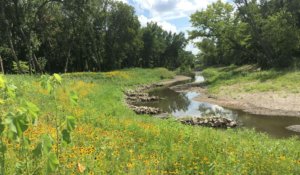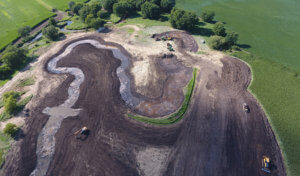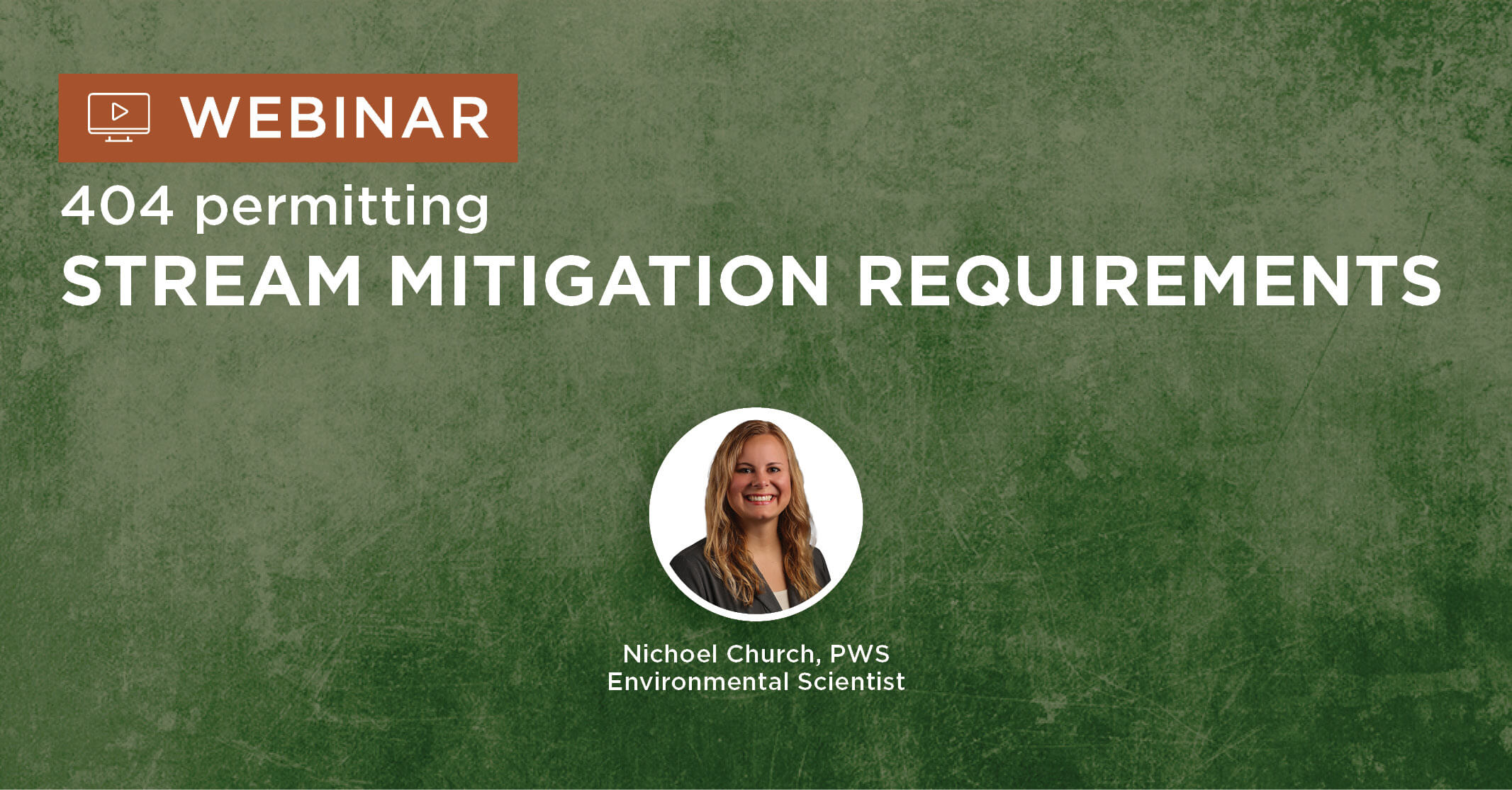Stream Mitigation Permitting & Requirements Webinar
By preserving and restoring wetlands, habitats, and streams in designated regions, we can minimize the damage caused to the environment. However, regulations and requirements can often hinder progress in achieving this balance. The science of stream mitigation is rapidly evolving, along with the development of state and Corps policies governing stream assessment and compensation requirements.
Join us as our environmental scientist, Nichoel Church, PWS helps define a clear path to stream and wetland mitigation through designated permits and requirements.
Webinar Agenda
- Fundamentals of 404 Permitting & Mitigation Requirements (0:17)
- Understanding the Clean Water Act (0:50)
- Types of Wetlands & Streams Commonly Found in Iowa (1:30)
- Defining Jurisdictional Waters (2:37)
- Regulations That Require Permits (5:37)
- Project Scheduling & Permitting (6:49)
- Triggering the Need for a 404 Permit (8:06)
- Calculating Impacts Through the Iowa Stream Mitigation Method (10:15)
- Compensating for Loss of Jurisdictional Resources (11:41)
- Permittee Responsible Mitigation (PRM) (12:09)
- Elements of PRM (13:20)
- Understanding the Benefits of Mitigation Banking (16:01)
- Breakdown of Snyder & Associates Mitigation Banks (17:08)

Nichoel Church, PWS
Environmental ScientistNichoel Church, PWS
Environmental ScientistMitigation banking development, Wetland delineation, Section 404 permitting, Endangered Species Act (Section 7 Consultation)
Fundamentals of 404 Permitting & Mitigation Requirements (0:17)
Hi, my name is Nichoel Church. I’m an environmental scientist with Snyder & Associates, and today I’m going to be talking about stream mitigation, fundamentals of 404 permitting, and mitigation requirements.
Snyder & Associates is a multidisciplinary civil engineering firm. Our repeat business focuses on government clients, and we serve several municipalities ranging from small towns to big cities. But we also have a large footprint within the private sector. We’ve been providing professional services for over 40 years, and I’ve had the pleasure of working with agencies all across the states where we have offices.
Understanding the Clean Water Act (0:50)
The Clean Water Act regulates the discharge of pollutants and navigable waters, outlines water quality standards, and promotes the no net loss of wetlands into Waters of the United States. A quote from the Clean Water Act, “to restore and maintain the chemical, physical, and biological integrity of the nation’s waters. A permit is required if waters of the US will be polluted or destroyed, and we call that filled.”
Today I’m going to be focusing on Section 404 and Clean Water Act mitigation requirements. But before we get into that, we have to understand what is a wetland. A wetland is comprised of hydrophytic vegetation, hydric soils, and hydrology.
Types of Wetlands & Streams Commonly Found in Iowa (1:30)

A restored stream with protected sanitary sewer infrastructure, improved ecological function, and stream habitat diversity.
Types of wetlands. In Iowa, our wetlands are classified by being emergent, scrub-shrub, or forested. Emergent is comprised of herbaceous vegetation, scrub-shrub wetlands are comprised of shrubs in the name, but they can also have herbaceous vegetation surrounding them, and then Forested wetlands are comprised of areas that are dominated by 50% or more canopy cover with trees that are 15 feet or taller.
Types of streams. There are Ephemeral, Intermittent, and Perennial streams. The Ephemerals flow only during and after rain events. Basically, they receive their rain either from tile or through runoff, and their water table is far below the stream bed, so they rely on that precipitation. Intermittent, they flow during normal conditions, so during a wet season. But, they don’t have to flow year-round, and they are connected to groundwater, and then precipitation and runoff just provides that supplemental flow. And then our perennial streams have continuous flow in the stream beds during most years. Basically, every year and the water table is located above the stream bed. So, their source of flow is groundwater, precipitation, and runoff.
Defining Jurisdictional Waters (2:37)
Now that we’ve talked about natural resources that are associated with permitting under Section 404 of the Clean Water Act, we’re going to talk about what is currently jurisdictional. Jurisdictional waters are regulated by the Clean Water Act, which is permitted by the US Army Corps of Engineers and enforced by the US Environmental Protection Agency. Again, the Clean Water Act just prohibits the discharge of pollutants from point sources into “navigable waters”, which are referred in the Clean Water Act as Waters of the United States. So the definition of Waters of the United States therefore really sets the boundaries for the Corps and EPAs authority, their jurisdiction.
In 2015, under the Obama administration, the Clean Water Rule was implemented, and federal courts ruled that the definition of Waters of the United States was too expansive. And then in 2020, under the Trump administration, the Navigable Waters Protection Rule came into play, and this new regulation completely removed ephemeral streams from being jurisdictional.
We are now under new regulation post Supreme Court ruling of the Sackett vs EPA case involving a couple from Idaho who were building a house near a lake and started filling in a portion of land that EPA stated contained jurisdictional wetlands. Before Sackett, the Corps of Engineers could take jurisdiction of wetlands within a landscape if there was connectivity to WOTUS (Waters of the United States), or through significant nexus, meaning there was physical, chemical, and biological connection to navigable waters.
The Supreme Court of the United States, commonly referred to as SCOTUS, rejected significant nexus because it is difficult, if not impossible, for landowners to determine whether or not the Clean Water Act would apply to their property. Additionally, it was thought undesirable for landowners to face fines or penalties for negligent violations due to significant nexus. So, the SCOTUS ruling forced the EPA and the Department of the Army to update their guidance, and in August 2023, they issued a rule to amend the final “Revised Definition of Waters of the United States”. The conforming rule was published in the Federal Register in September 2023.
This is where the relatively permanent standard comes into play. This is a test that the agencies now use to identify relatively permanent standing or continuously flowing waters and assert federal protection over these waters. Intermittent and perennial streams meet this definition. Ephemerals do not. Additionally, floodplains are now identified as areas that may contain waters and wetlands that would be near or adjacent to WOTUS and wetlands must have a continuous surface connection to such relatively permanent waters.
Moving forward onto non jurisdictional waters. We’ve got a broad list again. Basically just anything that is not considered a wetland by definition or does not have a defined bed and bank that could be determined to be a stream is likely non-jurisdictional if it does not have direct connectivity to a jurisdictional feature.
Regulations That Require Permits (5:37)
So, we understand what natural resources are protected under the Clean Water Act, and we know which resources the Corps and EPA have jurisdiction over through the Clean Water Act. Now, we’re going to move forward with regulations that require permits. So, the Clean Water Act talked about it already. We have Section 404, in which the Corps requires a permit for the discharge of dredger fill material into the “Waters of the United States,” and along with that Section 404 comes the state certification for water quality, which is under Section 401.
Additionally, we have the Rivers and Harbors Act of 1899, which could require a Section 10 permit for activities that could affect navigable “Waters of the United States.” In Iowa, that is the Mississippi River, Iowa River, Des Moines River, and the Missouri River.
So, I’ve mostly talked about 404, the Clean Water Act, and it requires permitting from the Corps for those impacts. In Iowa, we primarily work with the Rock Island District. As you can see from this map, they cover the majority of the state. However, we also work with the Omaha District, and I’ve never worked with the Kansas City District on a permanent impact in Iowa. Usually, the Corps in Rock Island or Omaha District will take jurisdiction, but technically, their jurisdictional boundary comes into Southern Iowa.
Project Scheduling & Permitting (6:49)
Project scheduling is very important for consultants, landowners, and municipalities that are involved. Whoever the applicant for the permit will be must understand that wetland delineations will be completed within the entire project area. We cannot complete wetland delineations in an area that we think might contain wetlands, for example, along the floodplain when an included project area could be a farm field, we can’t solely focus on the floodplain. We have to look at everything, so the floodplain and the farm field to document connectivity because there could be farmed wetlands in that field, and they may have connectivity to Waters of the United States.
And then drainage features as well. So they may not be jurisdictional, but we want to identify where ditches and any low depressional features are located.
And I already mentioned this, but we should be looking at the area along creeks. Just because we are in a floodplain doesn’t mean it’s going to be a wetland. Looking at the entire project area is very important so we can tell the Corps, here’s what we identified and here’s our baseline conditions for moving forward with permitting.
Wetland delineations can only be completed during the growing season, which is typically April through October. And wetland delineations are only good for a period of five years so if a project timeline could take longer than that, the wetland delineation might have to be completed again with an addendum attached to the original wetland delineation report.
Triggering the Need for a 404 Permit (8:06)
What would trigger the need for a 404 permit? We work on these day in and day out. Any sort of construction activity that could cross a stream or a wetland may include roads, bridges, trails, or development, and then any construction of dams, dikes, weirs, and impoundment structures may also trigger a permit. Replacing utilities, maintenance stream improvements, channelizing, stream bank stabilization such as placing rip-rap along the channel, dredging if there’s fill placement within WOTUS and culvert replacements. All of these are examples of typical activities we see every day that require permits.
Section 404 permitting does not always require mitigation. It’s very important to understand when we’re talking about permitting. That doesn’t mean that mitigation will be required. A permit may be required for a project, and it might have mitigation, but it might not.
What would trigger the need for mitigation are a tenth of an acre of wetland impact or 0.03 acres of stream impacts. Permits are different, and they’re quantified based on impacts as well, but for a nationwide permit, it has to be less than a half-acre of impact. Once you’re over that half-acre threshold, it bumps up to an individual permit, which takes longer, and there’s a lot of supplemental documentation required for that. And then for streams, the 404 Nationwide Permitting Thresholds used to be 300 linear feet, but starting in 2021, this changed to the same threshold as wetlands, which is a half-acre.
So we’ve talked about natural resources and what may or may not be jurisdictional as well as permitting. And along with permitting, proposed development, roadway, the Corps and DNR want to know how is your project avoiding Waters of the United States? Can the impacts to WOTUS be avoided or minimized? If they can be avoided, that’s the route they want you to take. And if they can be minimized, if the impacts to jurisdictional features could be less in any way, then they want you to talk about it. They also want you to talk about options that you’ve considered and why they were dismissed. And then, if those impacts cannot be avoided or minimized, that’s when mitigation can be triggered, and that could either be completed through permittee-responsible mitigation or through the purchase of mitigation credits, which we’ll talk about in just a little bit.
Calculating Impacts Through the Iowa Stream Mitigation Method (10:15)
So, the Iowa Stream mitigation method is used to calculate impacts for permits. It’s also used to develop mitigation banks, so it’s got an impact calculator, and then it’s got an extreme benefit calculator. This is used pretty widely throughout our state now, and it’s been really helpful in providing consistency across the Corps for stream impacts as well as establishing mitigation banks. On the impact side of things, we talked about that 0.03-acre threshold for streams. That is new, as in that it was established in the spring of 2022. That used to be 300 linear feet before that, and the Corps headquarters in DC just decided, “You know what, some districts were using the 300-foot rule, and some weren’t. Some had their guidelines on what they would use for mitigation. We’re just going to make it a standard 0.03 acres threshold for streams across the board.” So now, rather than just saying linear feet of stream, you have to calculate the length of the channel as well as the width that you are impacted.
And then, in that credit calculator, I should mention it also takes into account the type of channel it is. So, stream mitigation, when it is calculated through the calculator, it calculates it in credits. So, intermittent streams have a lower ratio compared to perennial streams because perennial streams are larger systems. They might have a higher impact. As well as the impact activity. Are you installing and replacing a culvert or expanding a culvert? Or is it something where it’s going to be a complete loss of channel for you filling in the channel or channelizing it, straightening the stream? So, each impact activity listed in the calculator has a certain ratio, and that is how credits are determined. Stream length is also considered.
Compensating for Loss of Jurisdictional Resources (11:41)
What is compensatory mitigation? We’ve talked about mitigation already, now we’re going to talk about the compensation for loss of jurisdictional resources. For example, your project has to impact 0.11 acres of wetland. Your obligation through 404 permitting is to offset the loss of wetland impacts either through the purchase of mitigation bank credit, which is option number one, or through permittee-responsible mitigation if mitigation bank credits are not available.
Permittee Responsible Mitigation (PRM) (12:09)
I’d like to talk about permitting responsible mitigation first, even though it’s the second option that the 2008 mitigation rule designates as preferred. There may not be credits available within a service area, so PRM would be required. Also, before the mitigation bank calculator was developed, we had stream mitigation banks, and this is how we completed projects.
Our Sugar Creek in West Des Moines required mitigation. Impacting a meander along the stream because it was eroded and needed to be stabilized for a new bridge crossing. There weren’t mitigation banks that offered stream credits, so we moved forward with permit-responsible mitigation, which was completed along Jordan Creek at Brookview Middle School in Waukee, Iowa. And what we did was we worked with the Corps and determined that we needed to remeander the stream a certain length. This channel was straightened, and the Banks were very eroded, definitely sized, and it was down-cutting. So, stabilizing the channel, as you can see in the upper right picture, was a success. It required monitoring and it required maintenance, and the city of West Des Moines had to work out a deal with the city of Waukee. Permittees responsible can be very expensive, especially if property acquisition is required, and they can also fail, and that is one of the reasons why the 2008 Mitigation Rule refers to the purchase of mitigation bank credit if available rather than completing PRM.
Elements of PRM (13:20)
Elements of PRM for stream mitigation requires planning and design, construction, annual monitoring and maintenance. Maintenance is completed to meet performance standards such as invasive species thresholds along the riparian buffer. In addition, if tree plantings were part of your mitigation plan, they have to have a high percentage rate for survival, and if they die, you’ll have to replace them and plant new trees. If your mitigation site fails, then you’ll either have to find a new mitigation site for PRM or purchase mitigation bank credits if available. There’s an additional risk component there.
Purchasing Mitigation Credits (13:55)
The first option in the 2008 mitigation rule hierarchy is to purchase credits from stream mitigation bank within your service area. This is an easy, time-saving way to satisfy the mitigation requirements for your permit. Basically, you write a check and walk away. There is no construction, no mitigation plan, no performance standards that require maintenance and monitoring.
Developing A Stream Mitigation Bank (14:15)
Developing mitigation banks, on the other hand, is a lot easier for the agencies because mitigation banks are larger and improve a larger area of natural resources rather than pocket postage size stamp permitting responsible mitigation plans that would be completed throughout an entire state. So it reduces the amount of mitigation plans coming into the agencies for review. They can focus on larger water quality improvement projects that benefit whole watersheds and service areas. It’s also an easy way to satisfy mitigation for the applicant. To develop a stream mitigation bank, you have to go through a 12 to 18-month approval process through what is called the IRT, which stands for the Inter-Agency Review Team. The IRT consists of the US Army Corps of Engineers, the US Environmental Protection Agency, Iowa Department of Natural Resources, US Fish and Wildlife Service, and the Natural Resource Conservation Service.
Through the approval process, a Bank Sponsor will submit several types of documentation, including a prospectus, a mitigation bank instrument, which includes a conservation easement, as well as moving forward with construction and an As-built maintenance and monitoring. For the Bank Sponsor, there is no guarantee when credits will sell. This isn’t a program that is compensated for within the first couple years. Mitigation banks typically have a range of 7 to 10 years, that should be considered for a long-term investment, but they’re very beneficial if you have a natural resource that needs to be improved. For this example, our Niebuhr Stream Mitigation Bank had approximately 3000 linear feet of stream that was re-meandered along a natural alignment before it was straightened to approximately 5,000 linear feet. We were also able to create wetlands along the riparian buffer, which helped with flood storage capacity and water quality improvements for tile outlets along the ag fields. So that was an added bonus.
Understanding the Benefits of Mitigation Banking (16:01)
There are several benefits of mitigation. Banking natural resources are improved, the Bank Sponsor intends to earn a profit through credit sales, or at a minimum, tries to recoup the cost of making improvements, and the watershed as a whole benefits too. It’s kind of a win-win all around.
I know we’re focusing on streams, but I wanted to throw in wetland mitigation bank benefits because they’re also an important resource that are protected under the Clean Water Act. Dam removal improves water quality and restores fish passage, but not all stream mitigation, banks remove dams. A couple other improvement examples include stabilizing streams by reconnecting floodplains, adding floodplain benches to help with the connection, daylighting tile outlets within the riparian buffer to improve water quality, re-meandering, straightened channels, and establishing riper buffer along channels that do not have a buffer today. So an example would be just a farm field converting that to riparian buffer to filter nutrients before the runoff hits the channel.
We already talked about daylighting tile and exposing tile outlets within the riparian buffer, allowing nutrient laden water to flow overland before flowing into the stream.
Breakdown of Snyder & Associates Mitigation Banks (17:08)
The first mitigation bank project that I worked on was Blackhawk Mitigation Bank. So this one’s near and dear to my heart. Credits were generated by improving stream, creating wetland and enhancing wetland.
Our Niebuhr Stream Mitigation Bank is located in Bremer County just north of Black Hawk County. I already talked about this one a little bit, but we took a straightened stream and restored sinuosity along a new channel alignment.

Niebuhr Stream Mitigation
The Des Moines River Mitigation Bank in Fort Dodge was established by removing two dams along the Des Moines River. The largest one was a Hydroelectric Dam. Additionally, we removed a low-head dam called the Little Dam. We also restored Riparian Buffer along the Des Moines River and at Sunkist Meadows Park in Fort Dodge, which now has a disc golf park full of native wildflowers, which the city loves. It’s more interesting to play disc golf in that setting rather than playing through a mowed, manicured lawn.
Our Byler Stream Mitigation Bank in Johnson County also re-meandered a straightened channel. This is one of our smaller mitigation banks, but it provided a huge benefit to the watershed.
Our Pabst Wetland and Stream Mitigation Bank was constructed in the spring of 2022. It’s located in Hardin County, and it had wetland and stream improvements. Stream improvements included stabilization of the stream banks and installing floodplain benches. We also added a few grade control riffles, two of which function as low water crossings, and then we established benches along the channel to reconnect it to its floodplain.
And those are just a few of the stream mitigation banks that we’ve worked on.
This concludes my presentation. I hope you guys learned something about 404 permitting and mitigation requirements. If you have any questions, feel free to reach out if we can help with permitting for your project. Thank you.
